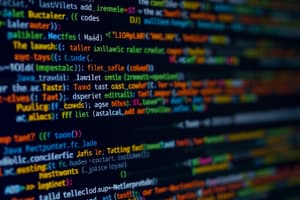Podcast
Questions and Answers
What is the primary purpose of a class in programming?
What is the primary purpose of a class in programming?
- To perform arithmetic calculations
- To serve as a blueprint for creating objects (correct)
- To define user interfaces
- To manage memory allocation
Which of the following statements is true about class instantiation?
Which of the following statements is true about class instantiation?
- It is the process of defining a class.
- It involves modifying the attributes of an existing class.
- It creates an instance of a class for use in a program. (correct)
- It refers to the destruction of class instances.
What does the 'protected' access modifier allow?
What does the 'protected' access modifier allow?
- Access exclusively to the class it defines.
- Access only within the same class or its subclasses. (correct)
- Access from all classes within the same assembly.
- Access to methods and variables from any class.
Which type of classes cannot be instantiated and only contain static members?
Which type of classes cannot be instantiated and only contain static members?
What is the correct syntax for instantiating a new class called 'Arithmetic'?
What is the correct syntax for instantiating a new class called 'Arithmetic'?
How are static methods and variables characterized in a class?
How are static methods and variables characterized in a class?
Which access modifier restricts access solely within its own class?
Which access modifier restricts access solely within its own class?
What does the 'internal' access modifier indicate about a class?
What does the 'internal' access modifier indicate about a class?
Flashcards are hidden until you start studying
Study Notes
Classes Overview
- Classes serve as blueprints for creating objects within a program, encapsulating attributes and methods.
- Programmers can create classes in the current file or in a separate file within the solution explorer.
Class Instantiation
- Instantiation involves creating an instance of a class to utilize it in a program.
- Syntax example:
ClassName Identifier = new ClassName();(e.g.,Arithmetic a = new Arithmetic();).
Access Modifiers
- Access modifiers determine the accessibility of classes, variables, and methods.
Class Access Modifiers
- Default/Internal: Class can only be accessed within the same assembly, not from other assemblies.
- Public: Class can be accessed from any other class.
Methods and Variables Access Modifiers
- Default/Private: Accessible only within its own class.
- Public: Methods and variables can be accessed from any class.
- Internal: Accessible only within the same assembly.
- Protected: Accessible only in the same class or in derived classes.
Static Classes
- Static classes cannot be instantiated and must only contain static methods and variables.
Static Methods and Variables
- Belong to the class itself rather than to instances, meaning they are shared across all instances of the class.
Studying That Suits You
Use AI to generate personalized quizzes and flashcards to suit your learning preferences.




